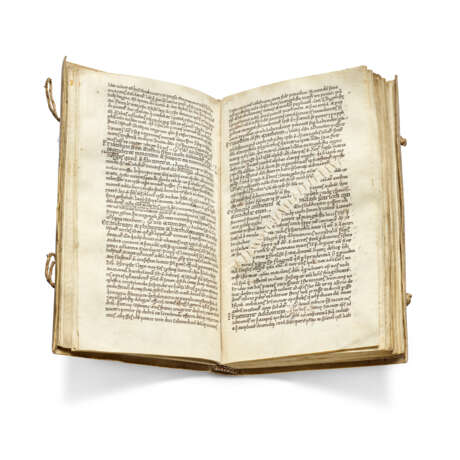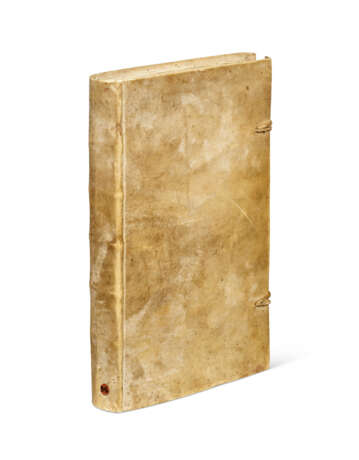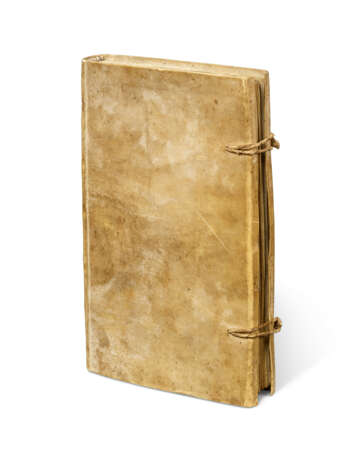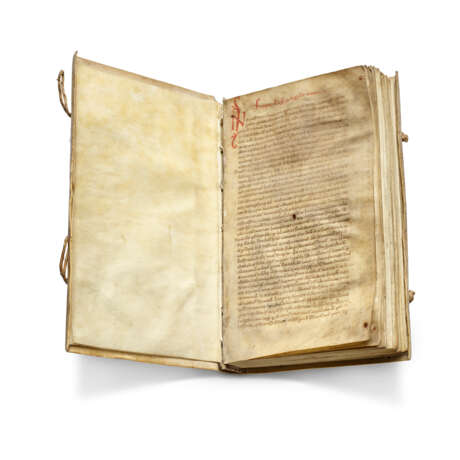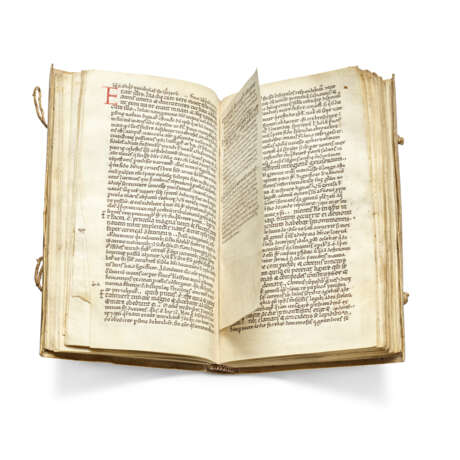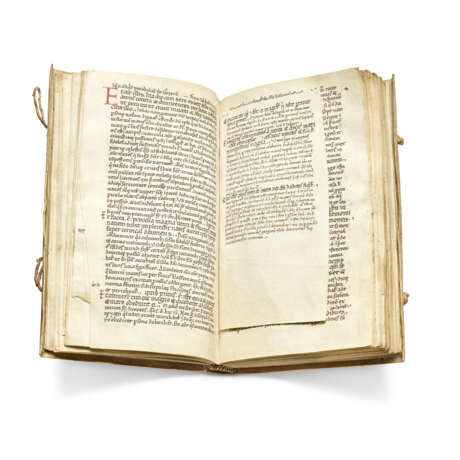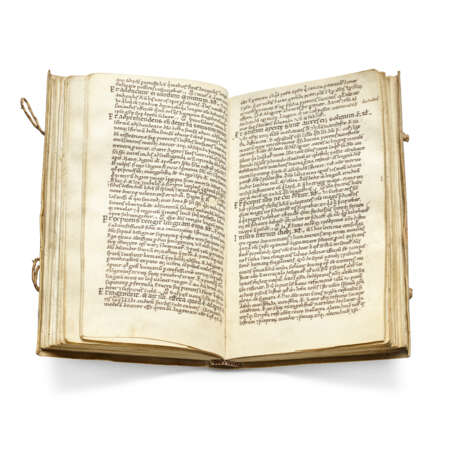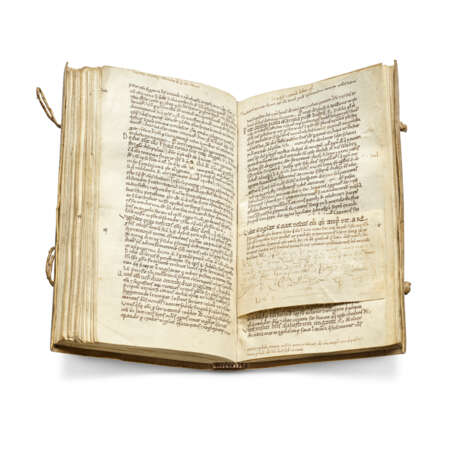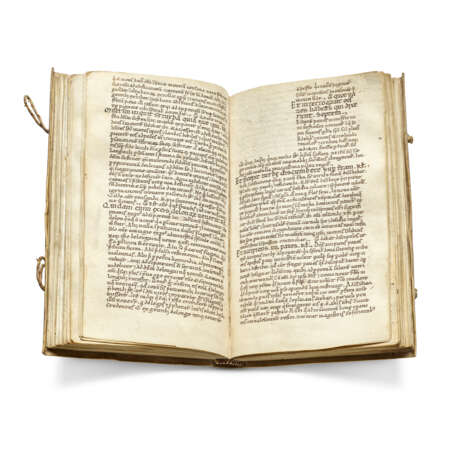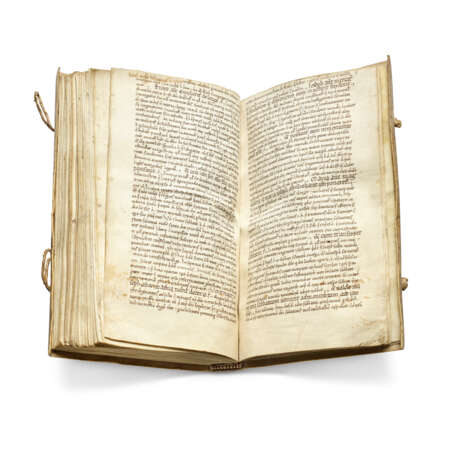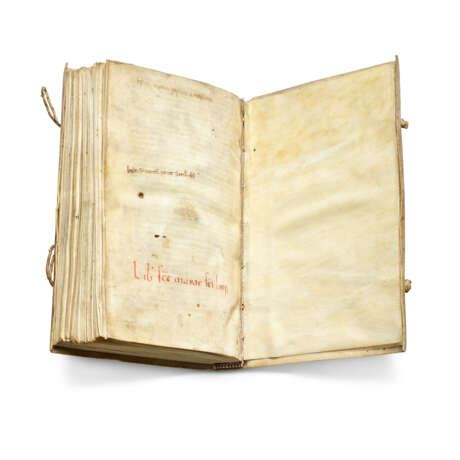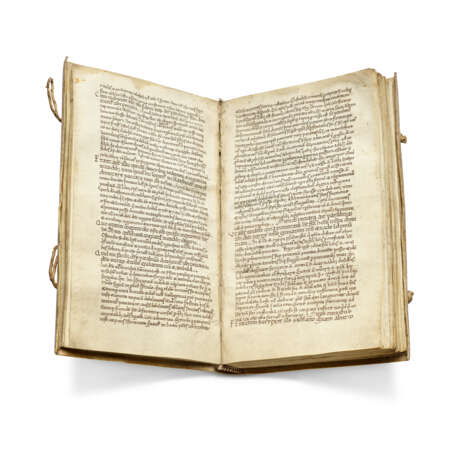ID 1214866
Lot 8 | The Venerable Bede
Valeur estimée
£ 300 000 – 500 000
Bede (c.672-735), In Marci evangelium expositio, in Latin, manuscript on vellum [France, Brittany, c.1050-1075]
An elegantly written early monastic copy produced for Notre-Dame de Locmaria, in Brittany, of one of the foundational texts for the study of the Gospels; a witness to the influence of the 8th-century Northumbrian scholar-monk Bede, the Venerable, in the outer reaches of Gaul; apparently the oldest copy auctioned since the 1960s.
210 × 130mm. i + 80 + i leaves, including ff.22 and 66, two contemporary inserted slips supplying accidentally omitted text, complete, collation: 1–98 (the slips inserted as 3 v and 8 vii), 106 (of 8, vii and viii cancelled blanks), a very unusual codicological feature is the remains of a series of original quire signatures in the form of letters of the alphabet in ink (‘d’ and ‘h’), which survive in the upper right corners of the first page of some gatherings (the normal position is the lower margin of the last page of each quire), prickings survive in all three outer margins, blind-ruled for 42 lines, ruled space: 175 × 90mm, written in late caroline minuscule in two sizes of script, each Book introduced by an enlarged initial in red, the first page with an ‘IN’ monogram with simple foliate ornament, the ‘I’ of the first rubric and the start of Book IV similarly ornamented (the first page darkened, some outer margins somewhat stained, not affecting the text, in a few places original tears in the parchment – made before the text was written – are artistically repaired with sewing). Bound in limp vellum yapp edges, with two twisted leather ties; the first leaf has rust-stained holes in a quincunx pattern caused by the metal fittings of a previous binding.
Provenance:
(1) The final page is inscribed in red ink in large letters with an 11th-century monastic ownership inscription ‘Lib(er) S(an)c(t)e Marie S(an)c(t)i Loci’ (f.18v). A previous cataloguer interpreted this as Notre-Dame de Locmaria, Quimper, Brittany, at the extreme western tip of France. While other interpretations are possible (for example, two manuscripts in London and Florence, both apparently from the abbey of Sept Fons, a Cistercian daughter-house of Clairvaux, in Burgundy, also have ownership notes that also begin ‘Liber Sancte Marie Sancti Loci’), the provincial style of the script, with its Insular features, and the very unusual form of quire signatures, supports a Breton origin: Colleen Durran points out that given the constant exchange of people and books between Brittany and southwestern Britain (particularly Wales) in the early medieval period, a more likely place of origin would have been Locmaria on Belle-Île, given its position in the middle of the nautical highway between Cornwall/Wales and Brittany.
(2) A. Villand, 1569: the inserted slip at f.66 is inscribed with a few lines of French, signed and dated ‘A Villand le xj dapuril 1569’.
(3) Private collection, eastern France, until 1995, when acquired by:
(4) Les Enluminures, Chicago; acquired the same year by:
(5) The Schøyen Collection, MS 2036.
Contents:
Among his many writings, in genres as wide-ranging as history, hagiography, computus, grammar, poetry, and others, Bede wrote theological commentaries on several books of the Bible, including Genesis, Samuel, Acts, the Pauline and Canonical Epistles, and the Apocalypse. Among the latter group were commentaries on the Gospels of Luke, composed between 709 and 716, and of Mark, the present work, composed after 716.
The text opens with a prologue, and then a summary of forty-six chapters numbered I–XLVI, followed by Book I and each of the other books, preceded by their own chapter-lists: ‘Incipit prologus ęvangelii Marci. In expossitionem [sic] evangelii secundum marcum […] (f.1) Explicit prologus, incipit capitula. .I. Esaiaę testimonio […] (f.1v) Explicit capitula. Incipit [Beda super – these two words added apparently by the hand of the ownership inscription] evangelium Marci. Initium evangelii Ihesu Christi filii dei […] (f.2r) Finit liber primus. Incipit secundus. Et ait illis. Illa die cum sero esset factum […] (f.21v) Explicit liber secundus. Incipit terci. Et post sex dies adsumsit […] (f.42v) Explicit Li. III. Incip. IIII. Et cum egredereatur de templo […] (f. 61v) […] ut eum liberi contemplentur per formam domini. Finit amen. (f.81)’. The text is edited by D. Hurst in the Corpus Christianorum, Series Latina, vol. CXX (1960).
Script and codicology:
The script is a regular, trained caroline minuscule with an Insular execution: there are wedged ascenders on 'b', 'd', 'l'; and the headstroke of 'a' barely extends above the lobe. Insular too are the numerous abbreviations and the backwards-leaning majuscule 's' in the lemma. Sentences or phrases of the biblical text are written in larger script, and these are each followed in smaller script by Bede’s commentary, a practice very similar to one seen in Irish manuscripts from the 11th century onwards (see for example the Liber Hymnorym at Trinity College Dublin).
The scribe has an imperfect understanding of the hierarchy of script; at the beginning of the main text, for example, he makes an erratic transition from majuscules to minuscules: ‘EXPLIciunt caPitula.' , and then he (or a colleague) fails to fully use the space allowed for the coloured initials of the incipit itself. An unusual scribal habit is the use of line-endings: because the scribe starts each biblical quotation on a new line, spaces are left at the end of the preceding line; so, when he reached the end of the new line, he utilised the space above the new line (separating this text from the already-present text with a symbol like a twisted scroll looking like a reversed ‘S’), before continuing below the new line. Two marginal notes (ff.27v, 60) use the insular form of the letter ‘g’ which suggests a geographical and/or cultural proximity to the British Isles, while the spelling with a ‘k’ of ‘katholicę’ (f.34) suggests that the exemplar or scribe may have been from a Germanic area.
An unexplained feature is a square blank area, 12 lines high, within the text space (f.38): at first glance it looks as if a large decorated initial has been erased, but this is not the case; it may be that this area of the parchment was poorly prepared and too rough to write on, so the scribe simply wrote around it; a much smaller space has been left in the corresponding place on the verso.
| Lieu d'origine: | Europe de l'Ouest, France, Europe |
|---|---|
| Catégorie maison de vente aux enchères: | Livres et manuscrits |
| Lieu d'origine: | Europe de l'Ouest, France, Europe |
|---|---|
| Catégorie maison de vente aux enchères: | Livres et manuscrits |
| Adresse de l'enchère |
CHRISTIE'S 8 King Street, St. James's SW1Y 6QT London Royaume-Uni | |
|---|---|---|
| Aperçu |
| |
| Téléphone | +44 (0)20 7839 9060 | |
| Commission | see on Website | |
| Conditions d'utilisation | Conditions d'utilisation |
